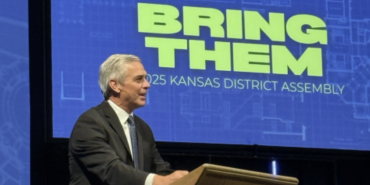True Colors

Traditionally, we Wesleyans have always looked a little odd when compared to our surrounding Christian culture. John Wesley himself seemingly spent his entire career in the British Isles clashing with the Calvinist majority over doctrinal issues, and the Anglican majority over issues of church practice.
Across the Atlantic, holiness revivals drew strong criticism from those who leaned in a more Catholic or Reformed direction. Even though Wesley-inspired churches (Methodist, Wesleyan, and Nazarene, among others) have spread around the world, we don't see the general picture of Christianity taking on a Wesleyan hue in too many places. That is not necessarily bad. Some aspects of the Christian faith never have been and never will be popular. The Christian faith inherently includes tensions that are difficult to maintain.
We Wesleyans have often believed that we were entrusted with the promotion and preservation of significant truths of the Christian faith.
Though some primary colors of truth exist on which all Christians agree, each theological tradition blends these colors in a unique palette.
Wesleyan Christianity has four unique colors that we need to boldly display in our lives and churches.The first color is one of community. Western, and western-influenced, culture tends to place supreme value on the individual. Individual rights are strongly affirmed and individual preferences validated.
Many Christians shop for churches the way others shop for cars, finding the one that best "meets their needs." As part of this, some churches have validated wide ranges of "individual morality," while others have focused on individual spiritual experiences that seem to make Christianity something "just between me and God." That's not enough, the Wesleyan says.
We must take into account God's focus on communities. From the very beginning, Wesley's vision of Christianity was strongly—even radically—communal. "Christianity is essentially a social religion, and to turn it into a solitary one is to destroy it," Wesley said. Early Methodists gathered to hold each other accountable for their spiritual lives, to edify one another, and even to confess their sins and shortcomings. We know that individuals are important to God, but we also know that we Wesleyans are who we are only in community.
We demonstrate this by annual and quadrennial meetings in many of our denominations. In a culture that says "Stand on your own," we say "We can only stand if we lean on one another." This emphasis on community complements a second, often distinctive, blend of colors found in the Wesleyan tradition, a blend we might call evangelical social engagement. Throughout the history of the Church, sub-groups have often emphasized either the personal-relational-evangelical side of the Christian faith or the social activist side. At our best, we Wesleyans have always understood this to be a false dichotomy. Wesley's Methodist groups both preached and served.
The early holiness folk held out God's offer of sanctification in one hand and a cup of soup in the other. "Of course," we Wesleyans say, "Christianity must be about our relationship with God! It is a personal relationship of grace that cannot, by its very nature, be earned or merited." But then we turn right around and say, "Of course, Christianity is about engagement with God in God's world! After all, the whole point of God's saving and sanctifying work is to make us agents of God, called to minister to, and demonstrate God's love for, everyone in need." That often means we look like social activists to those concerned about evangelization and vice versa, but that's okay. We believe the real color of the Kingdom is found in mixing both.
Blended with our evangelical social engagement is one of the brightest colors on our palette, this third mark of the Wesleyan tradition, called a "radical optimism of grace." Christians can sometimes sound pessimistic. Listening to believers, a person might sometimes start to think the world is hopelessly teetering on the brink of a total collapse. While we Wesleyans look at the world in sadness for all the damage sin has done, we also believe in a God who is always bigger than the problem. We believe that God is actively and redemptively at work in the world to bring about His Kingdom, and that His "new creation" work is ongoing, not merely reserved until the end of time.
When it comes to the problem of the sin nature, all Christians know it can be forgiven. Wesleyans also have the audacity to say it can be solved! However bad we know sin to be, we always know that where sin abounds, grace "super-abounds" (Romans 5:20). Many Christians look at the world and only pray for the grace to escape it. Wesleyans look at the world and pray for the grace to change it. All of these attempts to blend the colors of the Christian faith—the individual with the community, spiritual needs with material ones, the problem of sin with the solution of grace—arise out of a fourth color.
That is the way we approach God's palette of truths as found in Scripture. Much of the Christian culture—particularly in America—is very concerned about the proper view of Scripture, often giving the impression that what one believes about Scripture is more important than what one reads in it. Wesleyans share with others a very high view of Scripture—Wesley himself wanted to be known as a "man of one book," and that book was the Bible.
But the Wesleyan tradition has always placed more importance on how we use that book than in what we must believe about it. We love and revere the Scriptures because they point us toward God. We fervently read and attend to the Bible because it "inerrantly reveal[s] the will of God concerning us in all things necessary to our salvation" (Manual, Article 4). Even the order of our Articles of Faith reflects this.
We believe in the Scriptures because we believe in God, not the other way around.
This means that we will often be more flexible in our use of the Bible than other traditions.
In our attempts to combine the full range of biblical truth, we tend to allow for a greater breadth in interpretation. In all this, however, we give the Bible nothing but the greatest respect and authority because it is God's Word. We can read nothing else that is so effective in building our relationship to Him and letting Him paint our lives with His colors.
These colors are who we Wesleyans are—or at least a vision of who we ought to be at our very best. Far too often we have surrendered our distinctions and begun to look just like everyone else. But we aren't just like everyone else. Let's show our true colors, that God may use us to brighten this sin-darkened world.
Tim Crutcher is associate professor of church history and theology Southern Nazarene University.
Holiness Today, July/August 2006
Please note: This article was originally published in 2006. All facts, figures, and titles were accurate to the best of our knowledge at that time but may have since changed.




